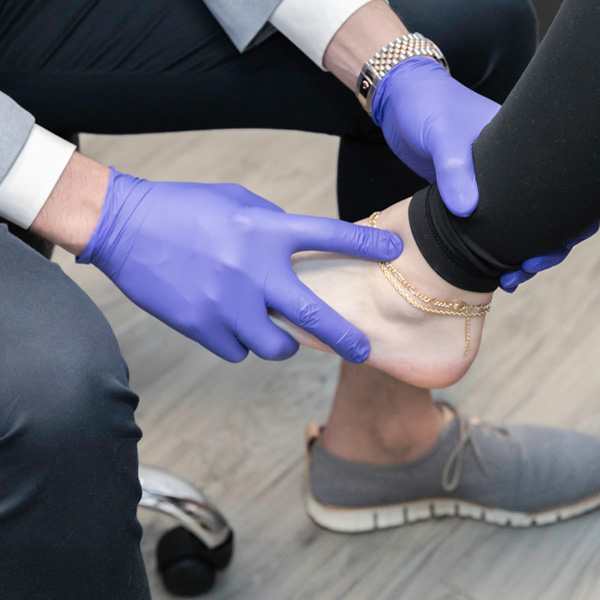When you injure your ankle, it can put a real damper on your physical activities. It is estimated that every day nearly one ankle sprain occurs per 10,000 people, making it one of the most common problems seen in acute medical care. A sprained ankle may severely limit your range of motion and make everyday tasks difficult. Therefore, finding ways to recover quickly is essential in returning to your daily routine.
Causes and Symptoms of a Sprained Ankle
A sprained ankle occurs when one or more supporting ligaments in the ankle joint are stretched or torn. This can happen when your foot rolls inward, known as inversion, or twists outward, called eversion. An ankle sprain may result from a fall, an awkward landing, or tripping on an uneven surface. Furthermore, wearing shoes that are ill-fitting or not adequately supportive may contribute to developing a sprained ankle as well.
The symptoms of an ankle sprain may vary in severity depending on the extent of the injury. Common symptoms of a sprained ankle include:
- Pain in the ankle that worsens with movement
- Swelling around the ankle
- Bruising around the ankle
- Instability or difficulty bearing weight on the affected ankle
- Redness or warmth around the ankle
If your ankle sprain is severe, you may also hear a popping noise and feel immediate sharp pain. This could be due to a ligament tear. Whether your ankle sprain is mild or severe, your injury should be treated by a foot and ankle specialist.
How to Care for a Sprained Ankle at Home
As soon as you injure your ankle, it is essential to take a break from physical activity. Continuing to put weight on a sprained ankle may lead to further injury and complications such as chronic ankle pain, arthritis in the ankle joint, and long-term instability.
The RICE method is often recommended as the first line of care for an ankle sprain, regardless of severity. RICE stands for:
Rest
Avoid any activity that puts weight or stress on your ankle. Using crutches may be necessary to keep weight off your ankle as it heals. The amount of time you need to rest your ankle depends on the severity of the sprain. Engaging in too much activity too soon may lead to re-injury and delay healing.
Ice
A swollen ankle can be painful and make movement difficult. Applying ice to the affected area in 15-20 minute intervals may keep swelling and pain under control. Do not place ice directly on your skin, as this may cause tissue damage. Instead, wrap the ice in a thin towel or cloth. Taking non-steroidal anti-inflammatory drugs (NSAIDs), such as ibuprofen, may also reduce pain and swelling.
Compression
Using an elastic compression bandage helps support your ankle and reduce inflammation. However, the bandage should not be wrapped too tightly, or it may interfere with blood flow which is necessary for healing. The bandage should be wrapped tight enough to stabilize the joint without causing a tingling sensation in your foot. Stabilizing the ankle with a splint or brace may also be recommended. Keep your ankle wrapped or braced for at least 2 to 3 days after the injury occurs or until the swelling goes down.
Elevation
In addition to using ice and compression, keeping your ankle elevated may also reduce swelling. Try to keep your ankle above heart level as often as possible. One way this can be achieved is by propping your ankle up on a pillow when sitting or lying down.
While the RICE method is often effective in treating a mild or moderate ankle sprain, more severe sprains may require additional treatment. Our team of experts at Alliance Orthopedics can develop a treatment plan to help you recover from your ankle sprain and help you get better faster.
Ways to Prevent an Ankle Sprain
Ankle injuries are often unpredictable and may happen despite taking proper precautions. However, there are some steps you can take to reduce your risk of developing a sprained ankle. By implementing preventative measures, you may keep your ankles healthy and reduce the likelihood of a sprain.
Tips for preventing an ankle sprain include:
- Warming up before physical activity
- Wearing supportive shoes
- Exercising on level surfaces
- Stretching regularly
- Building ankle strength
- Using an ankle brace on an injured or weak ankle during physical activity
If you would like to develop a plan for preventing ankle sprains or other injuries, Alliance Orthopedics experts have the knowledge and resources to help. Our board-certified foot and ankle specialist, Dr. Ammar Saymeh will work with you to find the best treatments and exercises to reduce your risk of injury and keep you healthy.
Recover from Your Sprained Ankle Faster with Alliance Orthopedics
If you are struggling to prevent ankle injuries or have already sustained an ankle sprain, Alliance Orthopedics can help. Our providers are experienced in treating various orthopedic conditions and will work with you to get better faster. Through our comprehensive multi-disciplinary approach, including physical therapy and cutting-edge sports medicine treatments, you’ll be back on your feet in no time. To learn more about our services or to schedule an appointment, contact us today.
Meet Dr. Ammar Saymeh!
Ammar Saymeh, DPM, AACFAS, FACPM, serves as the Director of Foot and Ankle Services at Alliance Orthopedics. Licensed to practice in New Jersey, Dr. Saymeh is board-qualified by the American Board of Foot and Ankle Surgery, board-certified by the American Board of Podiatric Medicine along with being certified in the Arthrex MIS Course Level III and the ProStep Minimally Invasive System by Wright Medical in techniques for both forefoot and rearfoot minimally invasive procedures.

